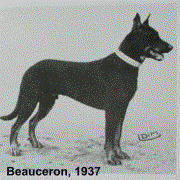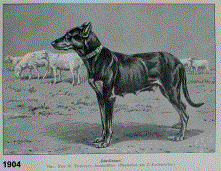 The Beauceron is the largest of the French sheepdogs. Though almost unknown outside of France, the Beauceron has a long history. It is a very old breed developed solely in France with no foreign crosses. It is thought that a passage in a manuscript, written in 1587, is the first specific mention of a dog of the Beauceron’s description.
The Beauceron is the largest of the French sheepdogs. Though almost unknown outside of France, the Beauceron has a long history. It is a very old breed developed solely in France with no foreign crosses. It is thought that a passage in a manuscript, written in 1587, is the first specific mention of a dog of the Beauceron’s description.
The Beauceron was a general-purpose dog. Worked and selected for a very long time, the Beauceron was used to drive and protect the herd (Sheep or Cattle), guard the house, and defend the family. Originating in the plains region surrounding Paris known as La Beauce, the Beauceron is also known as Berger de Beauce (Shepherd of the Beauce) or Bas Rouge (Red Stockings). The Beauceron is closely related to its longhaired cousin, the Briard or Berger de Brie.
In 1809, a priest, Abe Rosier, wrote an article on these French herding dogs. It was he who first described the differences in type and used the terms Berger de la Brie and Berger de la Beauce.
In 1809, a priest, Abe Rosier, wrote an article on these French herding dogs. It was he who first described the differences in type and used the terms Berger de la Brie and Berger de la Beauce.
The Society Central Canine was founded in 1882, and it registered in the Livres Origines Francais (LOF) the first ‘Berger de Beauce’ in September 1893. Bergere de la Chapelle, born in 1891 obtained the title of Champion of Beauty. Toward the end of the 1800s, M. Paul Mégnin differentiated between the Shepherd of the Brie and the Shepherd of Beauce. Assisted by M. Emmanuel Ball, M. Paul Megnin started to define the standard of the breed. In 1922, the Club des Amis du Beauceron was formed under the guidance of the respected M. Paul Megnin.
The French army also used the Beauceron. Their ability to follow commands without hesitation was well utilized during both wars in Europe, where the military used them on the front lines to run messages. Beaucerons were also used to pick up trails, detect mines and support commando activity. Today Beaucerons are still used as military dogs as well as police dogs.
In the 1960s the Ministry for Agriculture required that the S.C.C. create a confirmation examination with the goal of preserving the qualities of the ancient sheepdogs. There were concerns that because of the demands of modern day life, the Beauceron breed could well disappear. Fortunately, the adaptable Beauceron found work in protecting the home and family of his master, despite the disappearing flocks.
 The last modification to the French standard for the Beauceron was in 2006 and has been applied since November 9th, 2006. The minimum 5 year wait period made it possible for the breeders to adapt their breeding stock to the new standard. This is only the 6th time the standard has changed in 100 years.
The last modification to the French standard for the Beauceron was in 2006 and has been applied since November 9th, 2006. The minimum 5 year wait period made it possible for the breeders to adapt their breeding stock to the new standard. This is only the 6th time the standard has changed in 100 years.
Since the Sixties, the Beauceron’s popularity has grown in France. But it wasn’t until recently that the breed has become known outside of France. The Beauceron is gaining in popularity in many different countries, including here in the United States. Here he has attracted much attention due to his appearance and temperament.
The French writer Colette was a devotee of the breed and labeled the Beauceron “the country gentleman”. He described them as “affectionate, playful, superb with children, absolutely and deeply attached to their masters. But at the same time, there is something mysterious about a Beauceron. They are like some people who don’t talk much but have a strong presence. They have a dimension, a depth, I have not found in other dogs.”
Due to its great versatility, Beaucerons are utilized in a variety of areas. They are an eager and willing worker, whose intelligence and obedience, make them an extremely versatile and superior working dog. Today’s Beauceron is being used much in the same fashion as the German Shepherd dog in this country. While still tending sheep and cattle, the Beauceron is utilized for military and police work, Search & Rescue, handicapped assistance work, canine sports such as Agility, French Ring, Schutzhund, Obedience, Tracking, Skijoring, and of course as a family companion.
© Copyright 2014 American Beauceron Club. All Rights Reserved
